The proposal itself is extremely positive for the holders of COW tokens.
Author: Deep Tide TechFlow
In the DEX arena, apart from the well-established Uniswap and Sushiswap, what other emerging stars are worth paying attention to?
Today's DEX has long passed the era of simply competing in the number of trading pairs, liquidity, and depth. More consideration is needed for the reduction of costs and increased efficiency for user transactions—namely, how to spend less on transaction fees and execute trades more efficiently.
Therefore, when examining new protocols, it is also necessary to consider their integration with current hot topics, such as "intent" and MEV. The former can significantly improve the efficiency of trade execution, while the latter can reduce trading costs.
Following this line of thinking, Cowswap is definitely a project that cannot be bypassed.
Incorporating features such as batch trading, intent, and MEV protection, Cowswap aims to reduce the cost and increase the efficiency of user transactions. In this recent bull market, Cowswap has risen rapidly, with its token COW increasing by 360% in the past month;
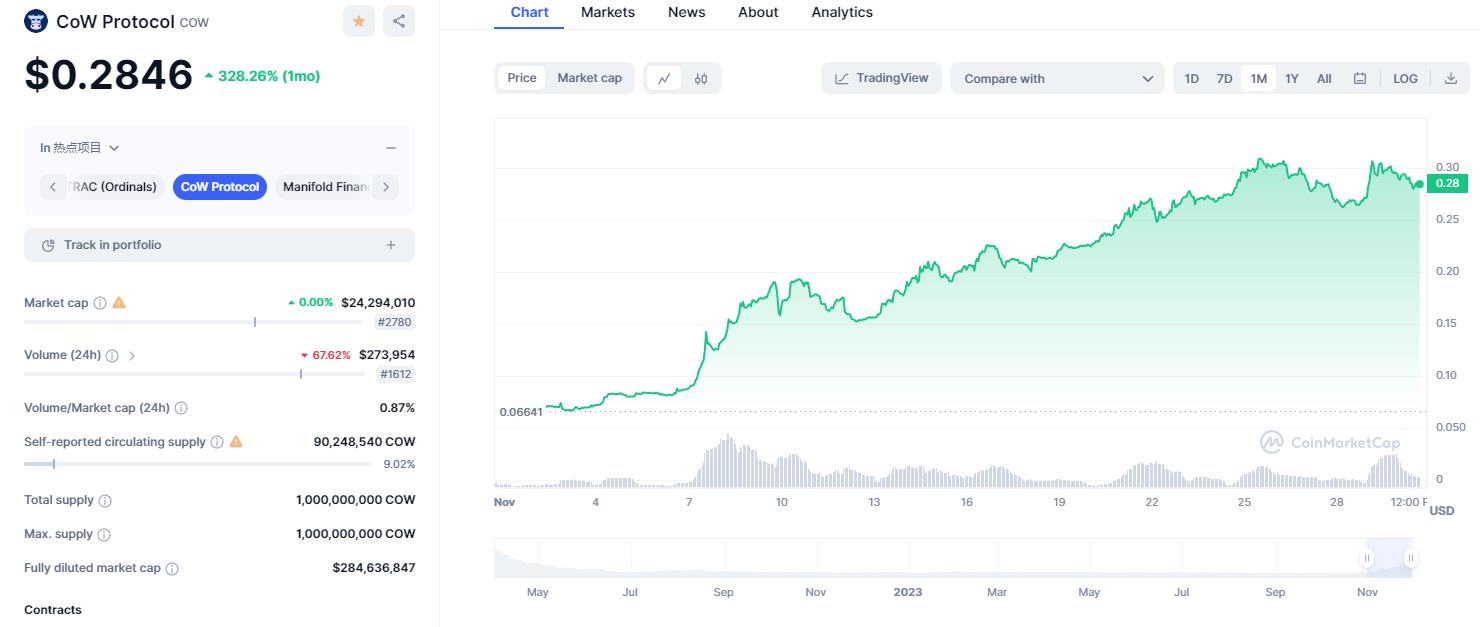
At the same time, on a fundamental level, the trading volume on Cowswap has continued to increase, reaching three billion US dollars in the past month. Although it cannot be compared with well-established DEXs like Uniswap in terms of volume, the upward momentum has made it one of the focus projects in recent cryptocurrency social media and research.
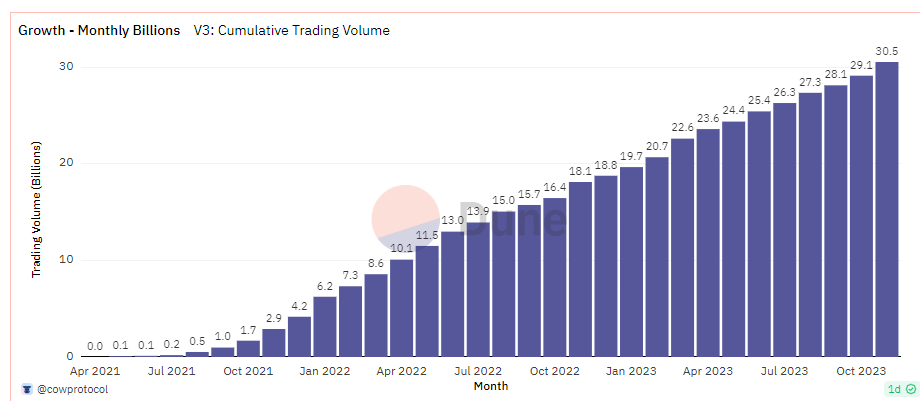
In addition to this background information, on November 28th, the Cowswap community quietly launched a proposal, hoping to improve the fee distribution structure in the current protocol, creating a win-win situation for users, solvers (a role in the protocol that processes transactions), and the protocol itself.
At the same time, the proposal also mentioned the concept of protocol fees, indicating that Cowswap itself has generated income.

However, for us, the key point to focus on is: the official proposal from Cowswap directly states that the proposal itself is extremely positive for the holders of COW tokens.
In other words, the value of the COW token may increase as a result of this proposal, which could potentially be a positive development for the secondary market price.
Given that the COW token has recently achieved a good increase, will this proposal become a new catalyst, continuing the upward trend of the COW token?
In this issue, we will interpret this proposal and study the innovations of the entire Cowswap.
Governance Proposal Update: Introducing Protocol Fees to Encourage Solver Competition
Before understanding this proposal, it is important to clarify a key role in Cowswap: the Solver.
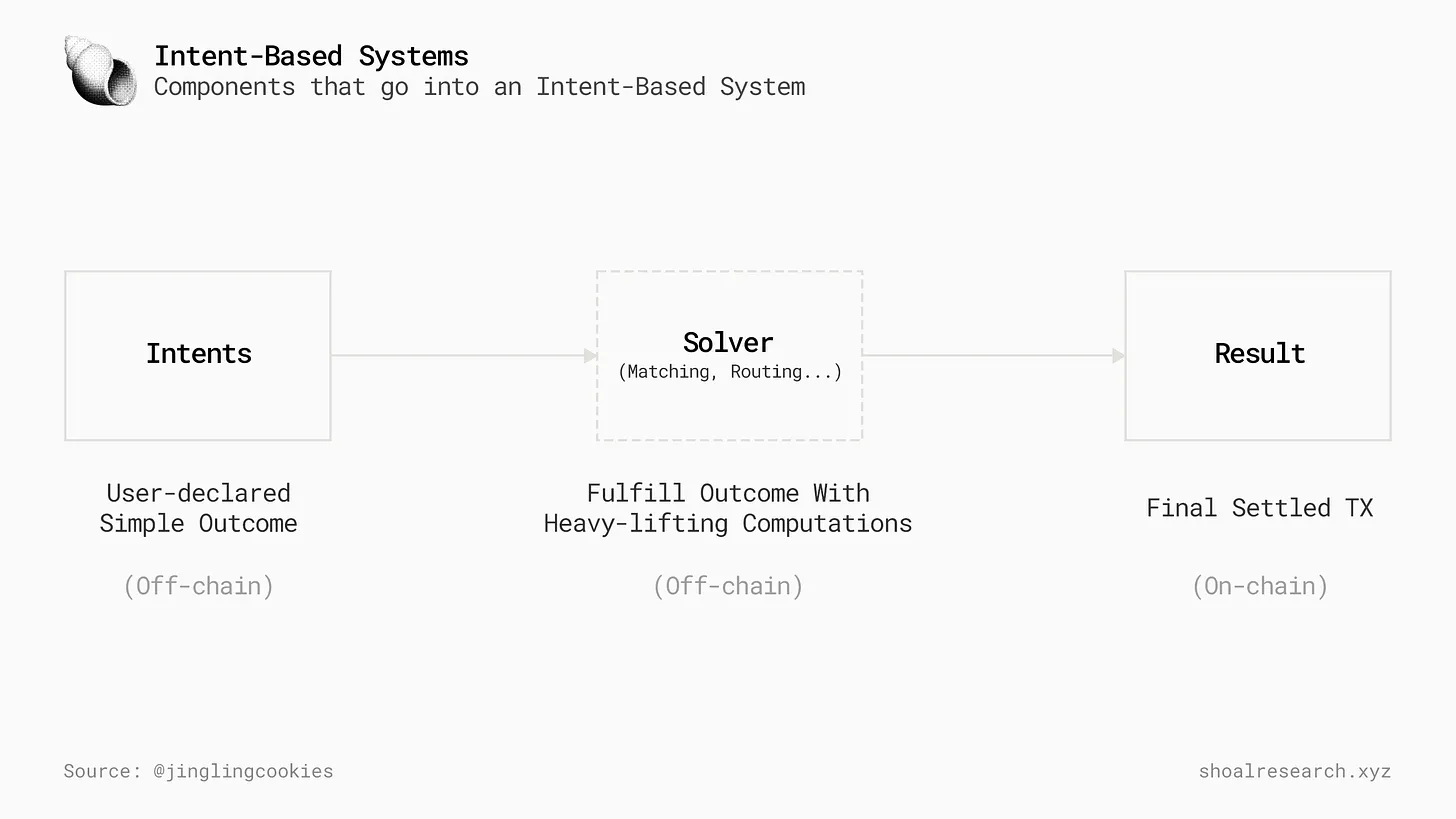
Different from traditional AMMs and order books, in Cowswap's trade matching, the Solver plays a crucial role:
- Users indicate their desired trade results based on intent;
- Cowswap batches these trade intents to form batch trade orders;
- Solvers compete to provide the best execution path for these orders, maximizing the user surplus (the amount of assets received by the user after the exchange);
- The execution methods used by solvers can be a combination of off-chain matching and on-chain exchange. Solvers who successfully execute orders in batch auctions will be rewarded.
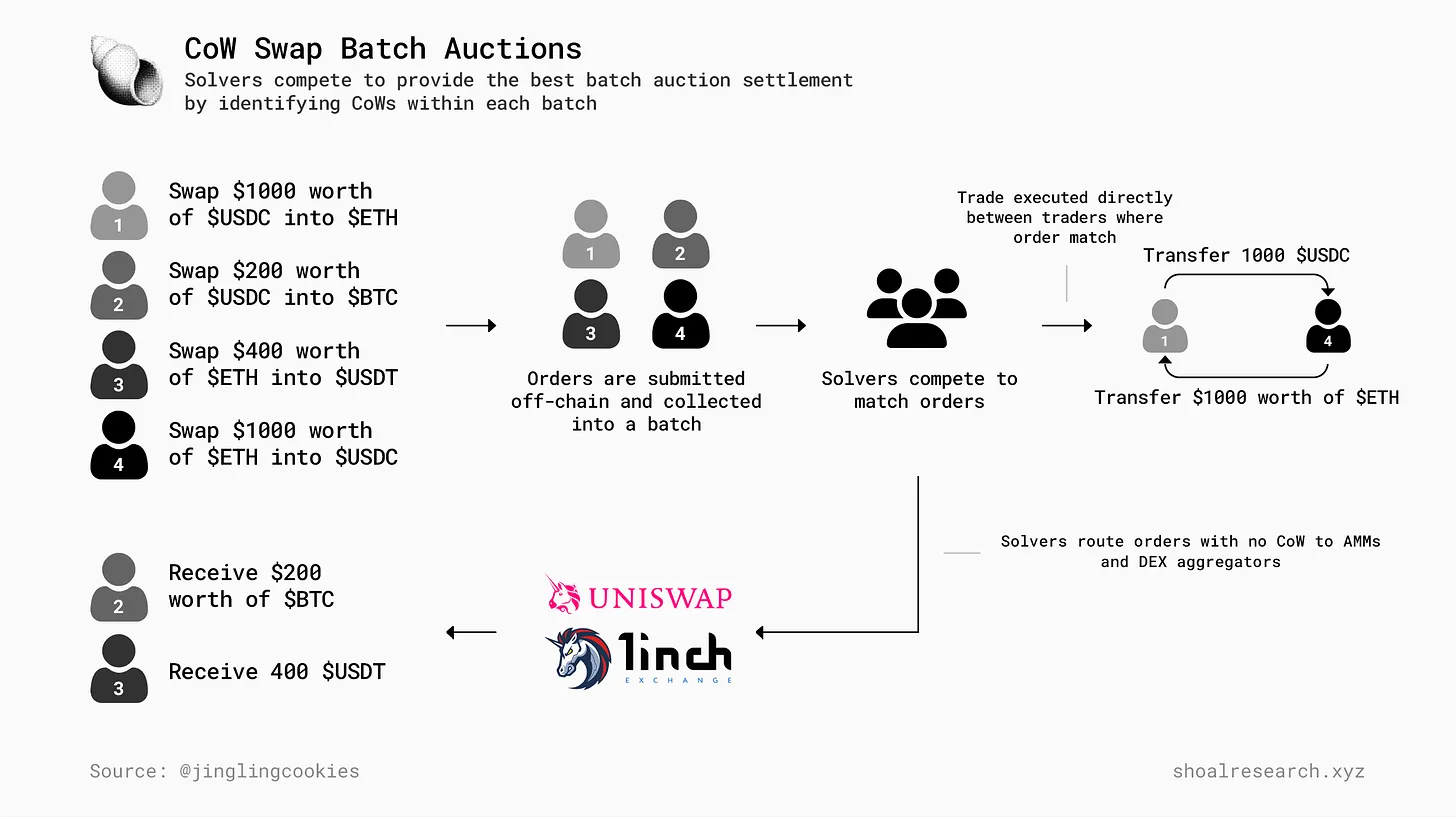
Putting aside the complex DeFi technical concepts, we can understand this trading process in simple terms:
You want to trade, I find a Solver to help you complete it, and reward the Solver.
Why find a Solver?
In the world of Cowswap, solvers are like a group of savvy brokers who constantly seek the best trading path to ensure that every trade is completed at the best price and lowest cost. Their work is precise and complex, requiring deep market resources and sharp strategic thinking.
In simpler terms, the Solver is like an optimized trading agent.
For example, if you want to exchange 1000 USDC for ETH, if the Solver happens to find someone who wants to exchange ETH for USDC, then you two are matched, and the trade can be completed directly through off-chain trading. This reduces the cost of trading and achieves the effect of reducing costs and increasing efficiency that we mentioned earlier.
At the same time, this situation is called a Coincidence of Wants, which is also the origin of the name Cowswap.
After understanding the role of the Solver, we can now look at the changes in this proposal.
- Before the Proposal: Charging first, then compensating
Before the proposal was put forward, what motivation did Solvers have to find the best trading path for you?
In the past, the CoW Protocol would charge users transaction fees and then use these fees to reimburse solvers for the gas costs incurred in finding the optimal path;
At the same time, the system would select the solution that provides the best liquidation price, maximizing the return for users (e.g., the lowest slippage, etc.), and the Solver providing the best solution would receive a reward in COW tokens.
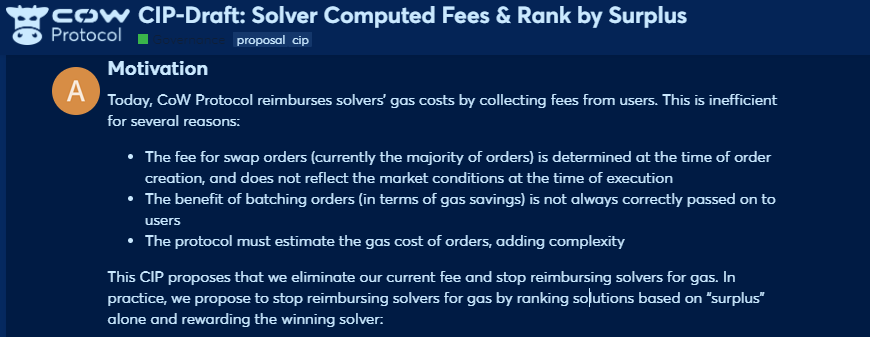
However, there are several issues with charging users fees in advance and then subsidizing Solver's gas costs:
The fees charged to users for their swap orders are determined when the order is created and do not reflect the market conditions at the time of execution. When executing trades, Solvers may face increased gas costs, and the fees charged by Cowswap may not cover the gas costs.
Users being charged fees in advance may not fully understand the thoughtful intentions behind Cowswap's request for Solver to match orders, batch trades, and other efforts behind the scenes. Even if doing so can ultimately reduce the slippage and costs of the trade, being charged fees in advance is still displeasing.
Cowswap must estimate the gas costs of user orders in advance, adding to the protocol's computational pressure and complexity.
- After the Proposal: Autonomous charging, encouraging competition
Under the new proposal, solvers will no longer be guaranteed to receive compensation exceeding the gas costs.
Cowswap will no longer charge users in advance. Instead, solvers will directly charge users "network fees" based on the current network conditions when executing trades, to cover the cost of solving.
Solver rewards will depend entirely on how much "surplus" they can create for users ("indicating the value users receive from Solver-optimized trade matching, usually manifested as lower slippage than the default slippage").
At the same time, CoW DAO is allowed to introduce protocol fees, collected by solvers on behalf of the CoW protocol, and then reimbursed to the protocol in the form of COW tokens on a weekly basis.
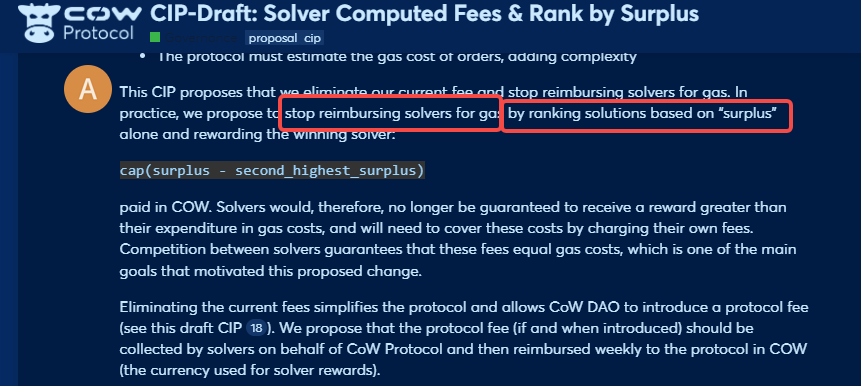
This means that previously, the protocol collected fees from users for trade optimization, and now it will be collected directly by solvers, with a portion of the fees flowing into the DAO in the form of COW tokens, creating protocol income.
From the user's perspective, there will be no change in the quotes seen during the swap, only the accounting will change.
Under the new proposal, solvers are incentivized to create more surplus, i.e., better trade results than the expected slippage. This not only improves the user's trading experience but may also make solvers more efficient in finding the best trading path.
Bullish for COW Token?
How will the changes in this proposal affect the COW token?
As mentioned in the previous translation "CoW Protocol: Potential Project with High Income Expectations and MEV Business Support," Cowswap's $COW token has been underperforming compared to $ETH over the past 18 months.
One of the reasons for this is the inflationary rewards paid to solvers.
From the current situation before the proposal, we can see that the protocol first charges users, then reimburses solvers to pay for their gas fees, and also rewards COW tokens to compensate them for their efforts in trade optimization.
Under the new proposal, solvers can charge users directly, meaning that the fees received are expected to cover the gas fees and provide some profit. However, a significant change is that solvers will directly charge users, most likely in ETH, as Cowswap trades on the Ethereum network, making it reasonable to use ETH as gas fees.
In this case, the protocol will no longer reward solvers with COW tokens, but it may be the balance of ETH they receive after deducting gas fees. Additionally, due to the introduction of "protocol fees," solvers will have to transfer a certain amount of COW tokens to Cowswap on a weekly basis, which means:
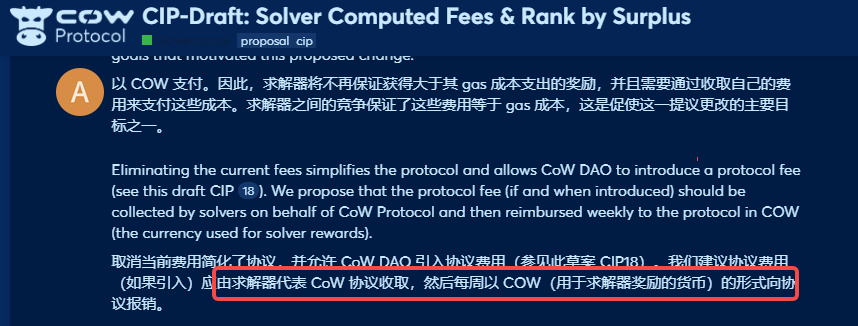
The circulating supply of COW tokens will decrease.
According to further estimates by overseas analysts, if Cowswap can "open the fee switch" and pay solver rewards in the form of ETH or stablecoins, the expected issuance of COW tokens will decrease by over 40%.
This proposal is a manifestation of opening the fee switch. The protocol now has the ability to collect protocol fees, and as long as there is trading demand, this proposal, once passed, will continue to receive protocol fees, entering the corresponding DAO treasury in the form of COW tokens, effectively reducing the circulating supply.
Real income + reduced circulating supply + MEV protection/intent narrative, theoretically, does indeed benefit the price of the COW token.
However, it is also necessary to consider whether Cowswap's market value and volume still have a significant gap compared to the leading DEX, whether there will be continuous user adoption, and how to strive for a larger market share to seek development, which also determines the success or failure of the project.
The changes in the proposal only provide an expected bullish perspective from an economic standpoint, but the specific development of the project still needs to be tested by the market and chosen by users.
At the same time, the proposal has not yet been formally approved, and according to the decision-making and discussion process, it is likely to take effect next year.
As a protocol focused on utility rather than MEME, the health of the fundamentals is the bottom line; short-term narratives and incentive plans may instantly raise the ceiling, and everyone needs to comprehensively judge based on both short-term and long-term information, as well as their own strategies.
Finally, due to space constraints and the efforts of colleagues, the detailed product design and token economics of Cowswap are not elaborated here, and there is an abundance of related content.
Some references:
Cowswap development estimate: "CoW Protocol: Potential Project with High Income Expectations and MEV Business Support"
Cowswap product design in detail: "CoW Swap: Intents, MEV, and Batch Auctions"
免责声明:本文章仅代表作者个人观点,不代表本平台的立场和观点。本文章仅供信息分享,不构成对任何人的任何投资建议。用户与作者之间的任何争议,与本平台无关。如网页中刊载的文章或图片涉及侵权,请提供相关的权利证明和身份证明发送邮件到support@aicoin.com,本平台相关工作人员将会进行核查。




